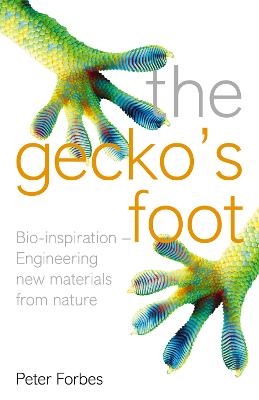
The Gecko’s Foot
Bio-Inspiration – Engineering New Materials and Devices from Nature
Seiten
2005
Fourth Estate Ltd (Verlag)
978-0-00-717990-9 (ISBN)
Fourth Estate Ltd (Verlag)
978-0-00-717990-9 (ISBN)
- Titel ist leider vergriffen;
keine Neuauflage - Artikel merken
A cutting-edge science book in the style of ‘Fermat’s Last Theorem’ and ‘Chaos’ from an exciting and accessible new voice in popular science writing.
Bio-inspiration is the new engineering. Instead of – in its crudest terms – welding large piece of hard 'dry' right-angled metal together scientists, architects and engineers are looking at imitating (or mimicking) nature by manufacturing 'wet' materials such as spider silk or the surface of the gecko's foot.
The amazing power of the gecko's foot has long been known – it can climb a vertical glass wall and even walk upside down on the ceiling – but nothing could be done with it because its mechanism was beyond the power of optical microscopes. Recently though the secret of the gecko's foot has been solved by a team of scientists in Portland, Oregon who have established that the mechanism really is dry, and that is does not involve suction, capillary action or anything else the lay person might imagine. Each foot has ½ million bristles and each bristle ramifies into hundreds of finer spatula-shaped projections. The fine scale of the gecko's foot is beyond the capacity of conventional microengineering but a team of nanotechnologists have already made a good initial approximation.
The gecko's foot is just one of many examples of this new 'smart' science. In Peter Forbes' accessible and engaging book we also discover, amongst other things, how George de Mestral's brush with the spiny fruits of the cocklebur inspired him to invent Velcro; how the shape of leaves opening from a bud has inspired the design of solar-powered satellites; how scientists are trying to mimic the self-cleaning leaves of the Scared Lotus plant to create the first self-cleaning pane of glass; and the parallels between cantilever bridges and the spines of large mammals such as the bison.
The new 'smart' science of Bio-inspiration is going to produce a plethora of products over the next decades that will transform our lives, and force us to look at the world in a completely new way. It is science we will be reading about in our papers very soon; it is the science of tomorrow's world.
Bio-inspiration is the new engineering. Instead of – in its crudest terms – welding large piece of hard 'dry' right-angled metal together scientists, architects and engineers are looking at imitating (or mimicking) nature by manufacturing 'wet' materials such as spider silk or the surface of the gecko's foot.
The amazing power of the gecko's foot has long been known – it can climb a vertical glass wall and even walk upside down on the ceiling – but nothing could be done with it because its mechanism was beyond the power of optical microscopes. Recently though the secret of the gecko's foot has been solved by a team of scientists in Portland, Oregon who have established that the mechanism really is dry, and that is does not involve suction, capillary action or anything else the lay person might imagine. Each foot has ½ million bristles and each bristle ramifies into hundreds of finer spatula-shaped projections. The fine scale of the gecko's foot is beyond the capacity of conventional microengineering but a team of nanotechnologists have already made a good initial approximation.
The gecko's foot is just one of many examples of this new 'smart' science. In Peter Forbes' accessible and engaging book we also discover, amongst other things, how George de Mestral's brush with the spiny fruits of the cocklebur inspired him to invent Velcro; how the shape of leaves opening from a bud has inspired the design of solar-powered satellites; how scientists are trying to mimic the self-cleaning leaves of the Scared Lotus plant to create the first self-cleaning pane of glass; and the parallels between cantilever bridges and the spines of large mammals such as the bison.
The new 'smart' science of Bio-inspiration is going to produce a plethora of products over the next decades that will transform our lives, and force us to look at the world in a completely new way. It is science we will be reading about in our papers very soon; it is the science of tomorrow's world.
Peter Forbes has written a series of articles Biomimetics for the Guardian and a chapter on the same subject for the Guardian’s book, ‘Frontiers 03’ (Atlantic Books). He was the editor of Poetry Review from 1986 to 2002 and his anthology ‘Scanning the Century: The Penguin Book of the Twentieth Century in Verse’ was widely acclaimed. He translated Primo Levi’s personal anthology, ‘The Search for Roots’, (Penguin Press) in 2001 and Bloodaxe published his latest poetry anthology ‘We have come through’ in 2003.
| Erscheint lt. Verlag | 15.8.2005 |
|---|---|
| Verlagsort | London |
| Sprache | englisch |
| Maße | 159 x 240 mm |
| Gewicht | 526 g |
| Themenwelt | Sachbuch/Ratgeber ► Natur / Technik |
| Technik | |
| ISBN-10 | 0-00-717990-1 / 0007179901 |
| ISBN-13 | 978-0-00-717990-9 / 9780007179909 |
| Zustand | Neuware |
| Haben Sie eine Frage zum Produkt? |
Mehr entdecken
aus dem Bereich
aus dem Bereich
eine neue Sicht auf unsere Emotionen
Buch | Hardcover (2023)
Rowohlt Taschenbuch (Verlag)
CHF 39,20
was die Physik über die Welt und das Leben verrät
Buch | Hardcover (2023)
Siedler (Verlag)
CHF 36,40
Buch | Softcover (2024)
Wiley-VCH (Verlag)
CHF 25,20


